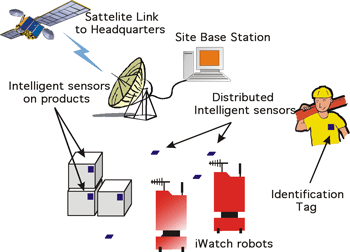
This issue in pdf Subscription Archive: Next issue: January 2006 |
|
||||
iWATCH: Intelligent Watch Based on Networked Smart Sensors and Autonomous Mobile Vehiclesby Haris Baltzakis, Angelos Bilas and Panos Trahanias The iWATCH activity aims at developing an embedded network of intelligent sensors and autonomous mobile platforms that will enable localization, identification and tracking of mobile assets, goods and people within the context of a real-life monitoring application. Recent events and changes in society have created an increased demand for security, which in turn has forced governments and organizations to make personal and asset security a priority. For example, London, the most populated city in Europe, has recently instituted some huge security programs, largely based on CCTV surveillance systems. Because of these programs, thousands of CCTV cameras have been installed for surveillance in various areas of interest (eg more than ten thousand cameras in the London metro and Heathrow airport alone). However, cameras are of little use without some means of analysing the data they record. A review in 2002 by the Home Office, the British government department responsible for internal affairs, found that the cameras had a 'small effect' on crime and did not address terrorism at all; other studies have also been inconclusive. London's police admitted that regarding the utility of sensor data, manpower is a major limitation: for the cameras to be useful for spotting terrorists, an army of police would have to be on hand to scrutinize the images. In addition, the current security boom is to a great extent an export of the United States. The 2004 Athens Olympics was the first summer Olympic Games since the September 11th terror attacks, and the most heavily guarded event in history. The security budget for this single event exceeded one billion euros – more than three times the amount spent on protecting the previous Olympic Games (Sydney 2000). Most security systems for the Athens Olympics were provided by US companies and more specifically by a group of companies under the US-based SAIC (Science Applications International Corporation).
Most existing systems rely on stationary sensors such as cameras and motion detectors for surveillance and tracking. Easy deployment, scalability and customizability are also very important issues for security systems. For this reason, the current trend of taking over the processing, communication and sensing capabilities from workstations and gradually embedding them in the sensors themselves is expected to pick up in the years to come. In the long run, the 'disappearing computer' will hand over its competences to smaller devices embedded virtually everywhere in the environment. Usually such sensors do not possess any processing power and no communication takes place between them. Besides sensors, small passive information tags are commonly used for identification of products and persons as well as for anti-theft control. iWATCH is an interdisciplinary activity at FORTH-ICS. It aims to use existing state-of-the-art technology and expertise in this important application domain, and conversely, to use the specific application domain to drive further work on the underlying technology. The focus of iWATCH is to investigate how situation awareness and security in large-scale premises and assets of global interest can be improved by integrating various devices under a common framework that involves:
Finally, iWATCH brings together researchers from autonomous vehicles, intelligent sensors, networking, and signal processing and capitalizes on existing, cutting-edge expertise and technology in order to provide automated tracking, identification, mapping and inventory control for assets and persons as well as patrolling by autonomous mobile vehicles in large-scale premises. Link: Please contact: |
||||


